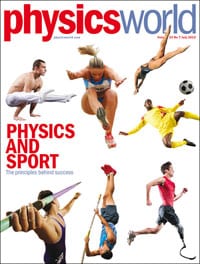By Matin Durrani
Ernest Rutherford used to enjoy “noisy and appalling” golf at Cambridge with his Trinity College colleagues. Niels Bohr was a keen footballer who played in goal for the top Danish side Akademisk Boldklub in the early 1900s. Arthur Eddington was a passionate cyclist who coined the “Eddington number”, E, which is the number of days on which you have cycled at least E miles. (He reached an incredible 84.) And, of course, CERN physicists are handily placed for a spot of Alpine hiking, climbing and skiing when their hunt for the Higgs has worn them down.

But for some physicists, sport is more than just something they take part in – it is what they study too. This month’s issue of Physics World looks at some of the challenges in the “physics of sport”, including the effects of technology and rule change on sporting performance, the physics of the prosthetic devices that are leading disabled athletes to success, and how gymnasts, divers and long jumpers are all unconscious masters of manipulating the law of conservation of angular momentum.
Members of the Institute of Physics (IOP) can access the entire new issue free online through the digital version of the magazine by following this link or by downloading the Physics World app onto your iPhone or iPad or Android device, available from the App Store and Google Play, respectively.
The digital issue also contains a trio of unmissable videos on the physics of running, cycling and swimming filmed with Steve Haake, director of the Centre for Sports Engineering Research at Sheffield Hallam University.
Here’s a rundown of other highlights of the issue:
• SKA’s double site splits opinion – The decision to build the world’s biggest radio telescope – the Square Kilometre Array – on two separate sites in Africa and Australasia has been praised by many. Jon Cartwright examines if the split site will hamper its science prospects
• Supercharging Japan’s atom smasher – The KEKB collider in Japan is halfway through a major revamp that may help to explain why there is more matter than antimatter in the universe, as Michael Banks reports
• Critical point: Sporting knowledge – When we say that athletes “know” the laws of physics, what we really mean, argues Robert P Crease, is that they know the laws of “physics”
• An impaired cosmic vision – The European Space Agency recently picked a probe to Jupiter as its next large-class mission. Paul Nandra, a director of the Max Planck Institute for Extraterrestrial Physics in Garching, Germany, says the decision could devastate astronomy
• The fastest man on no legs – Prostheses remained unchanged for thousands of years, but that all changed once amputee athletes got involved in the design process. James Poskett explores the stories behind the elite sports prostheses we see today
• Material advantage – Sprinters are running faster than ever before, but why are javelin throwers not throwing further and swimmers not swimming faster? Steve Haake, director of the Centre for Sports Engineering Research at Sheffield Hallam University in the UK, explains the effects of technology and rule change on sporting performance
• Balance, angular momentum and sport – Roland Ennos from the University of Manchester explains how athletes and the rest of us use simple physics principles to perform amazing balancing acts
• Technology for life – The fight against cancer offers rewarding career opportunities for medical physicists as well as healthcare professionals, as Giulia Thompson, who leads the R&D team at Elekta, describes
• Once a physicist: Crispin Duenas – the University of Toronto physicist who will be representing Canada in archery at this summer’s Olympic Games
• The Great Physics Games – In this month’s Lateral Thoughts column, Kate Oliver takes a wry look at how physicists compete to succeed
If you’re not yet a member, you can join the IOP as an imember for just £15, €20 or $25 a year via this link. Being an imember gives you a full year’s access to Physics World both online and through the apps.



